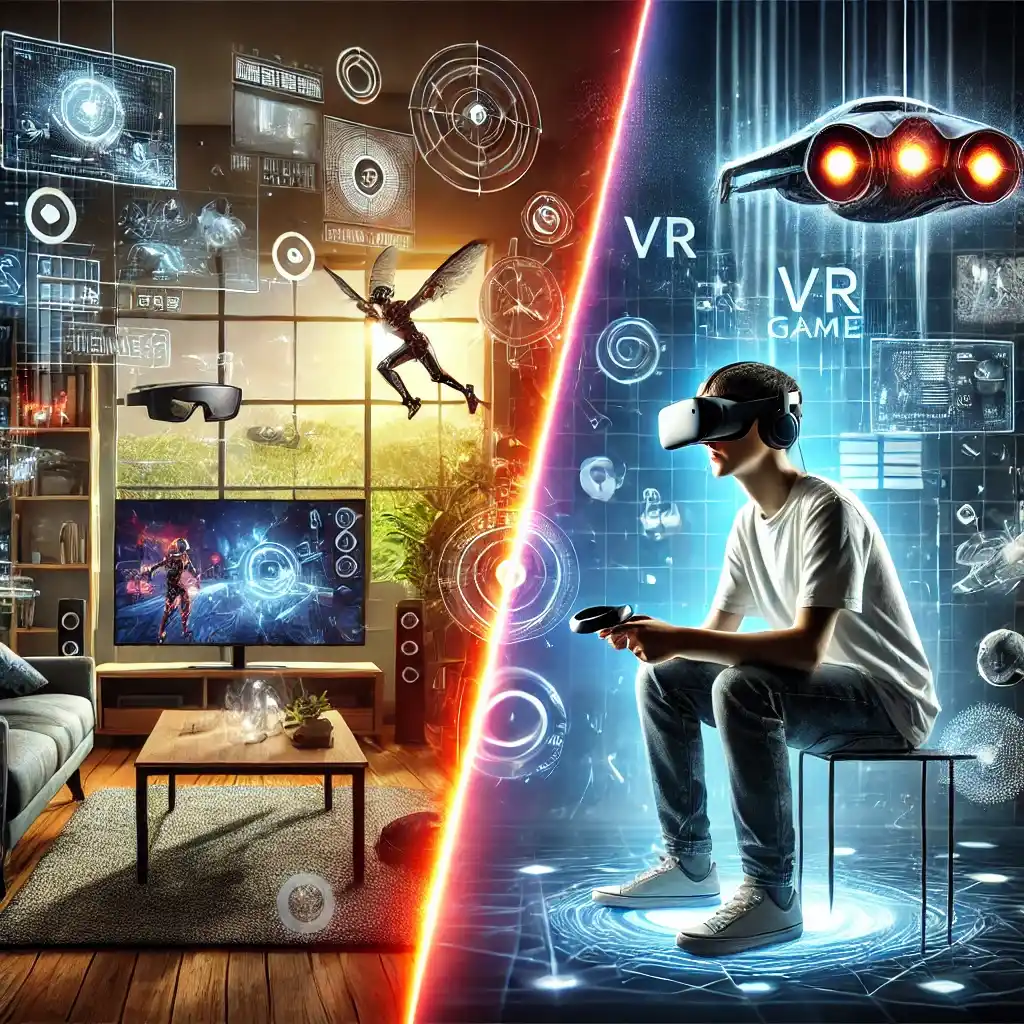AR vs. VR: Which is Better for Gaming in 2025? This question is crucial for gamers looking to experience the most immersive technology. There came a technological revolution in the gaming industry with immersion experiences of augmented reality (AR) and virtual reality (VR). While both these technologies have their own unique means of engaging the users, which could be better from 2025 to 2030 for gaming purposes requires a brief clarification about their individual features, advantages, and disadvantages. This article delves into comparing AR and VR in games to help you choose the one that will meet your preferences or needs.
Understanding AR and VR in Gaming
Augmented Reality (AR) AR was developed to enhance the presence of the real world by overlying some sort of digital element to enable an interactive or immersive experience. Popular examples are mobile games such as Pokémon GO, where the virtual object perfectly blends within the same space in which people live.
Virtual Reality (VR), on the other hand—immerses players in an entire 3D simulated virtual space, usually with the usage of the Oculus Quest or HTC Vive. The experience delivers a contextual 360-degree world around the people, completely separating them from reality, and providing a much deeper level of immersion.
According to TechCrunch, AR and VR gaming are rapidly evolving, bringing new levels of immersion to players.
AR vs. VR: Which is Better for Gaming in 2025? Key Differences Explained
Key Features of AR Gaming
- Integrated Real Environments: AR games use actual environmental backgrounds as the main setting for gameplay, merging digital items into the physical world.
- Device Accessibility: Most AR games are accessible to free or cheap on smartphones and tablets, so no specialized hardware is needed.
- Social Interaction: AR enables group play and outdoor play settings to foster social interaction.
- Location-Based Learning: Games adjust based on location for a very unique experience at every single spot.
Key Features of VR Gaming
- Complete Immersion: VR gaming immerses its user into entirely virtual worlds with a sense of presence that no other medium can provide.
- High-end interface and hardware: Devices such as VR headsets and motion controllers are crucial and provide precise tracking and life-like interaction.
- Rich graphics with sound: Most VR games are graphically superior and also possess 3D audio which gives the right feel of realism and depth.
- Physical Engagement: In VR games, players often move around while playing, meaning that it is often immersed with gym exercise.
Advantages of AR for Gaming in 2025

- Cost-effectiveness: AR-based games include those with video-enabled smartphones and tablets, hence they are less costly than VR.
- Mobility: AR-enabled games offer the convenience of play-anywhere-indoor and outdoor.
- Easy to Use: Without any investment and without the requirement of special gaming equipment, AR games are easy to set up and play.
- Social Connectivity:The real-world interaction of AR tends to enhance the experience of group gaming.
Advantages of VR for Gaming in 2025

- Immersive Gameplay: For adventure, simulation, and first-person games, the lifelike environment that VR can create offers an ideal experience.
- Broadening Game Library: VR gaming is developing at a quick pace, presenting diverse genres and titles.
- More Physical Activity: Many VR games promote physical movement and provide enjoyment in keeping up with fitness.
- Enhanced Realism:With superior graphics and authentic sound, it offers a level of realism like nothing else.
Limitations of AR in Gaming
- Device Limitations: The game becomes restrictive due to the limitations of the smartphone or tablet with respect to characteristic.
- Lack of Immersion: Somewhat interesting, as other platforms are immersive in quality, AR cannot be fully immersive like a VR product.
- Environmental Dependency: AR gaming is dependent on a wide range of environmental contexts which may not be absolute for successful play.
Limitations of VR in Gaming
- Cost Consideration: The investment in hardware and various peripherals requires expenditure; hence, VR does place itself outside the threshold of affordability.
- Isolation from the World: Incompatibility with the environment surrounding and with others is one other drawback around VR gaming.
- Space Requirements: Some VR games need a good amount of space to move around, thus also sometimes may customarily limit some users playing.
AR vs. VR: Gaming Trends in 2025

AR Gaming Trends:
- Growing utilization of AR glasses for further immersive gameplay.
- Integration of AI-based characters into AR games.
- Growing interest in location-based AR games that advocate exploration.
VR Gaming Trends:
- Haptic feedback systems are enhancing for tangible experiences.
- Development of multiplayer VR platforms to create social gaming.
- Introduction of wireless VR headsets for augmented mobility.
AR or VR: Which Is Better for Gaming in 2025?

AR or VR depends on what you like and what you can afford. AR is truly what you might need if you seek mobility, affordability, and social interaction. But VR offers a totally different experience-being immersed in an exciting experience with ever-extending visuals and willing to spend some bucks on hardware.
When comparing AR vs. VR: Which is Better for Gaming in 2025, it’s clear that both have unique strengths for different gaming styles.
Conclusion
With the growth of gaming technology, AR and VR are reforming the interaction of gamers with virtual worlds. While AR shines in accessibility and real-world integration, VR literally reaches unheard-of levels of immersion and realism. Ultimately, the best choice for gaming in 2025 depends entirely on the statures and gaming goals a particular person may have. Explore both technologies yourself to find your own trait with it to enjoy future gaming. Many gamers are still wondering, AR vs. VR: Which is Better for Gaming in 2025? The answer depends on personal preference and game type.
To explore more about how these technologies differ, check out our detailed guide on Augmented Reality vs. Virtual Reality: Key Differences and Use Cases.
FAQ:
1. AR vs. VR: Which is Better for Gaming in 2025?
Answer:
The choice between AR and VR depends on gaming preferences. AR enhances real-world environments with digital overlays, making it more accessible. VR, however, offers a fully immersive experience but requires specialized hardware.
2. Which is more affordable for gaming, AR or VR?
Answer:
AR gaming is usually more affordable since it runs on smartphones and tablets, while VR gaming requires dedicated headsets and controllers, which can be costly.
3. What are the key differences between AR and VR gaming?
Answer:
AR gaming blends virtual elements into the real world using mobile devices or AR glasses. VR gaming, on the other hand, fully immerses players in a computer-generated environment, requiring headsets and motion controllers.

